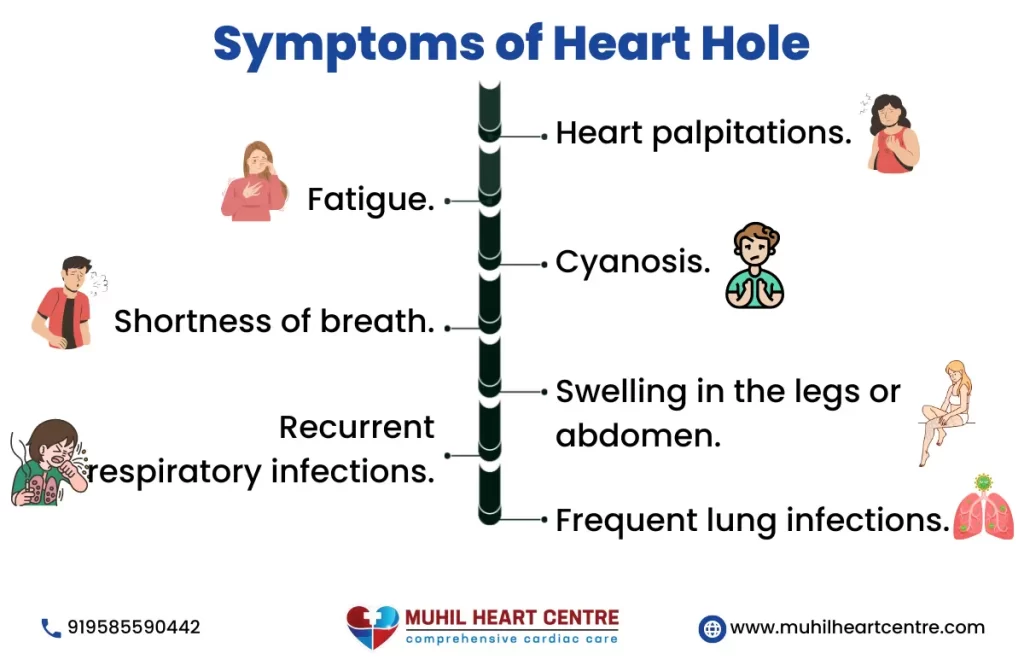Heart diseases encompass a wide range of conditions that affect the structure and function of the heart. In this blog post, we will explore different types of heart diseases, including congenital heart diseases such as ventricular septal defect (VSD) and atrial septal defect (ASD), heart valve diseases, arrhythmias, cardiomyopathy, and heart failure. Understanding the characteristics and heart hole treatment in Vellore for each type of heart disease is crucial for early detection, effective management, and improved patient outcomes.
Let’s delve into the world of cardiac health and learn how these conditions can be diagnosed and treated for an individual who has a heart valve disorder in Vellore.
Congenital Heart Diseases: Exploring Ventricular Septal Defect and Atrial Septal Defect
Congenital heart diseases refer to heart abnormalities present at birth. Two common types are ventricular septal defect (VSD) and atrial septal defect (ASD), both of which involve holes in the heart. VSD occurs when there is a hole in the wall separating the heart’s lower chambers (ventricles), while ASD involves a hole in the wall separating the heart’s upper chambers (atria).
The heart hole treatment in Vellore for these conditions ranges from monitoring for spontaneous closure in mild cases to surgical interventions, such as patching the hole or using devices to close it.

Heart Valve Disease
Heart valve diseases occur when the valves that regulate blood flow within the heart are damaged or malfunctioning. Common valve conditions for heart failure in Vellore include mitral valve prolapse, aortic stenosis, and mitral regurgitation.
Treatment options for Heart valve disorders in Vellore diseases depend on the severity and specific valve involved. Medications, lifestyle modifications, and regular monitoring are often prescribed for mild cases. However, more severe cases may require heart hole treatment in Vellore using surgical or minimally invasive procedures.
Arrhythmia
Arrhythmias are irregular heart rhythms that can manifest as a heartbeat that is too fast (tachycardia), too slow (bradycardia), or irregular. Heart hole treatment in Vellore for arrhythmias varies depending on the specific type and severity.
Treatment options for heart failure in Vellore regulate the heart’s electrical signals, cardioversion to restore a normal rhythm, catheter ablation to correct abnormal electrical pathways, and implantable devices such as pacemakers or defibrillators to regulate heart rate and rhythm.
Cardiomyopathy
Cardiomyopathy refers to diseases of the heart muscle that weaken its ability to pump blood effectively. There are different types of cardiomyopathy such as hypertrophic cardiomyopathy, dilated cardiomyopathy, and restrictive cardiomyopathy.
Heart hole treatment in Vellore for cardiomyopathy may involve medications to manage symptoms and slow the progression of the disease, lifestyle modifications, and in some cases, surgical interventions such as implanting a ventricular assist device or heart transplant.
Heart Failure
Heart failure arises when the heart’s ability to adequately pump blood falls short of meeting the body’s requirements. Heart valve disorders in Vellore can result from various underlying conditions, including coronary artery disease, high blood pressure, or previous heart attacks.
Heart hole treatment in Vellore typically involves a combination of medications to manage symptoms, lifestyle changes (such as a heart-healthy diet and regular exercise), and in more severe cases, surgical interventions such as bypass surgery or the implantation of a ventricular assist device or heart transplant.
Causes of the Heart Hole Treatment in Vellore
A hole in the heart, medically referred to as a “congenital heart defect,” is a condition where there is an abnormal opening in the septum, the wall that separates the heart’s chambers. This condition can affect both newborns and adults, and its causes are multifactorial, often involving a combination of genetic and environmental factors.
Genetic Factors
Genetics plays a significant role in the development of congenital heart defects, including holes in the heart. Sometimes, a child is born with a defect due to a genetic mutation or abnormality that occurred during the early stages of fetal development. Certain genetic syndromes, such as Down syndrome, can increase the likelihood of congenital heart defects, including holes in the heart.
Environmental Factors
During pregnancy, various environmental factors can contribute to the development of congenital heart defects. Maternal factors such as maternal diabetes, obesity, smoking, and alcohol consumption can increase the risk. Exposure to certain medications, infections (such as rubella), and toxins during pregnancy can also play a role.
Fetal Developmental Factors
The heart develops very early in pregnancy, and any disruptions in this process can lead to structural abnormalities, including holes in the heart. Sometimes, a hole may occur due to incomplete closure of the septum during the fetal development stages. This can be influenced by various factors, including disturbances in blood flow or genetic predisposition.
Blood Flow Abnormalities
Abnormal blood flow patterns during fetal development can impact the heart’s formation and lead to congenital heart defects. A hole in the heart can develop if there is excessive blood flow between the heart’s chambers due to altered pressures, causing the septum to not close properly.
Maternal Health Conditions
Certain maternal health conditions can increase the risk of congenital heart defects in the baby. For example, poorly controlled diabetes can affect fetal development and increase the likelihood of heart defects, including holes in the heart.
Age of the Parents
Studies suggest that the age of the parents may also play a role in the development of congenital heart defects. Older parents, especially the mother, may have a slightly higher risk of having a child with such defects which requires comprehensive heart hole treatment in Vellore.
Other Medical Conditions
Some medical conditions in the mother, such as lupus or certain autoimmune disorders, can increase the risk of congenital heart defects in the baby. Additionally, maternal use of certain medications during pregnancy can contribute to the development of heart defects.
While the exact causes can vary from case to case, it’s important to note that medical advancements have allowed for early detection and effective heart hole treatment in Vellore giving affected individuals the opportunity to lead healthy lives with appropriate medical care. Pregnant individuals are advised to maintain a healthy lifestyle, attend regular prenatal check-ups, and follow medical guidance to minimize potential risks to their baby’s heart development.
Available Treatments for Heart Hole Treatment
The term “heart hole” typically refers to congenital heart defects that involve openings or abnormalities in the structures of the heart. The two most common types of “holes” are atrial septal defects (ASDs) and ventricular septal defects (VSDs).
Observation
Small and asymptomatic heart holes, especially in the case of ASDs, may not require immediate intervention. In some cases, healthcare providers may choose to monitor the condition and wait to see if the hole closes on its own over time.
Medication
Medications may be prescribed to manage symptoms associated with heart holes. For example, medications to control heart failure symptoms or to prevent infections may be recommended.
Cardiac Catheterization
Minimally invasive procedures such as cardiac catheterization can be used to repair certain types of heart holes. During this procedure, a catheter is guided through blood vessels to the heart, where a device such as a septal occluder can be placed to close the hole.
Open-Heart Surgery
For larger or more complex heart holes, open-heart surgery may be necessary. Surgical repair involves making an incision in the chest and directly accessing the heart to close the defect with sutures or a patch.
Hybrid Procedures
In some cases, a combination of minimally invasive techniques and surgical approaches may be used, known as hybrid procedures. This approach aims to achieve the benefits of both methods.
Conclusion
Understanding the different types of heart diseases and treatments for heart failure in Vellore is crucial for early detection and effective management. Whether it’s congenital heart diseases like VSD and ASD, heart valve diseases, arrhythmias, cardiomyopathy, or heart failure, advancements in medical technology and interventions provide hope for patients.
Read also Depression Treatment in Vellore.


